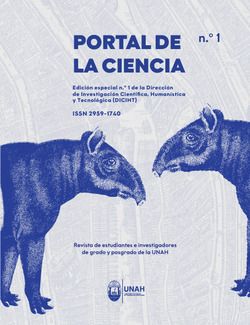Potential species for tapir (Tapirus bairdii) food gardens in captivity
DOI:
https://doi.org/10.5377/pc.v1i17.16075Keywords:
palatability, tapir, zoos, food enrichmenzAbstract
Tapirs are browsing herbivores consuming a wide variety of plants. In captivity they may present a deficit in plant material consumption, therefore, to complement their diet, is necessary to evaluate potential palatable plants for feeding gardens. Two palatability tests were performed on a captive tapir at Rosy Walther Zoo, located in the department of Francisco Morazán, including 53 plant species, which were compared with a list of plant species reported as consumed in wild tapirs’ diet. Consumed species were evaluated using a weighted matrix based on three criteria: reproduction, or propagation viability, biomass production, and nutritional quality. From the offered plants, 86.8 % were accepted, of which 16 have high potential to be cultivated to complement the diet of captive tapirs. We recommend to build nurseries with the species suggested in this study in addition with local plants for the establishment of permanent feeding gardens. This will supply safe vegetable fiber to complement nutritional requirements that would guarantee a better life quality for tapirs in captivity.
Downloads
227
Downloads
Published
How to Cite
Issue
Section
License

This work is licensed under a Creative Commons Attribution-NonCommercial 4.0 International License.
© Revista Portal de la Ciencia
Los autores/as que publiquen en esta revista aceptan las siguientes condiciones:
De acuerdo con la legislación de derechos de autor, Revista Portal de la Ciencia, reconoce y respeta el derecho moral de los autores, así como la titularidad del derecho patrimonial, el cual será cedido a la revista para su difusión en acceso abierto en versión impresa y en formato digital. Al formar parte de múltiples indexadores, bases de datos y sistemas de referencia, los artículos que sean publicados por Revista Portal de la Ciencia se encontrarán visibles y serán descargados también de estos sitios web, indicando, en todos los casos, la autoría de los artículos, la fecha de publicación y el número de la revista al que corresponden.

Este obra está bajo una licencia de Creative Commons Reconocimiento-NoComercial 4.0 Internacional.
Usted está en libertad de:
- Compartir: copiar y redistribuir el material en cualquier medio o formato
- Adaptar: remezclar, transformar y crear a partir del material
Bajo las siguientes condiciones:
- Reconocimiento: Usted debe darle crédito a esta obra de manera adecuada, proporcionando un enlace a la licencia, e indicando si se han realizado cambios. Puede hacerlo en cualquier forma razonable, pero no de forma tal que sugiera que usted o su uso tienen el apoyo del licenciante.
- Uso no comercial: Usted no puede hacer uso del material con fines comerciales.




